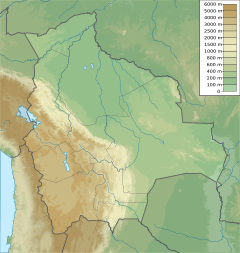Gastrotheca splendens facts for kids
Gastrotheca splendens is a special kind of frog that lives only in Bolivia, a country in South America. It belongs to the family Hemiphractidae, which includes frogs that often carry their eggs in a pouch, like a kangaroo! This frog is also known as Schmidt's marsupial frog. This name honors Eduard Oscar Schmidt, the scientist who first described this amazing frog way back in 1857.
We don't know much about Gastrotheca splendens because it's very rare. So far, only two of these frogs have ever been found! Both were discovered on the eastern slopes of the Andes mountains, specifically in the Amboró National Park in the Santa Cruz Department of Bolivia.
Quick facts for kids Gastrotheca splendens |
|
|---|---|
| Conservation status | |
| Scientific classification | |
| The only precisely known record of Gastrotheca splendens is from the Amboró National Park in Bolivia | |
| Synonyms | |
|
Contents
What Does It Look Like?
The very first Gastrotheca splendens ever found was a female. She was about 45 mm (or 1.8 inches) long from her nose to her bottom. The other frog found was a male, a bit bigger at 51 mm (about 2 inches).
This frog has a body that is quite strong and sturdy. Its head is a little wider than it is long, but it's not as wide as the rest of its body. The front of its face, called the snout, is gently rounded.
Special Features
Gastrotheca splendens has a clear tympanum, which is like an eardrum on the side of its head. There's also a small fold of skin above this eardrum.
Its fingers have small, round pads, called discs, which help it grip surfaces. There's also a little bit of skin between the fingers, like a small web. The toes have discs too, but they are slightly smaller than the ones on the fingers. The toes are less than half-webbed.
The skin on the frog's back is smooth. When preserved, these frogs look dull grayish-brown or tan on their backs. They have dark brown markings. The female frog has small, uneven spots, while the male has larger spots. The underside of the frog is creamy white. It has dark brown speckles along its lips and on the sides of its chest and belly.
Where Does It Live and How Is It Protected?
The first Gastrotheca splendens was collected in 1857, but its exact location is not known. The second frog was found much later, in 1996. This male frog was discovered in a cloud forest at a high elevation of 2,286 m (about 7,500 feet) above sea level.
Even though scientists have searched the area, no new Gastrotheca splendens frogs have been found since 1996. This means the species is likely very rare.
Threats to Its Survival
This rare frog faces several dangers. One big threat is habitat loss. This happens when its forest home is destroyed for farming or to build roads and other structures.
Another potential danger is a disease called Chytridiomycosis. This is a serious fungal disease that affects amphibians like frogs all over the world.
Because this frog is so rare and its habitat is threatened, protecting the Amboró National Park is super important. Managing the park well helps ensure that Gastrotheca splendens and other unique animals can survive and thrive in their natural home.



